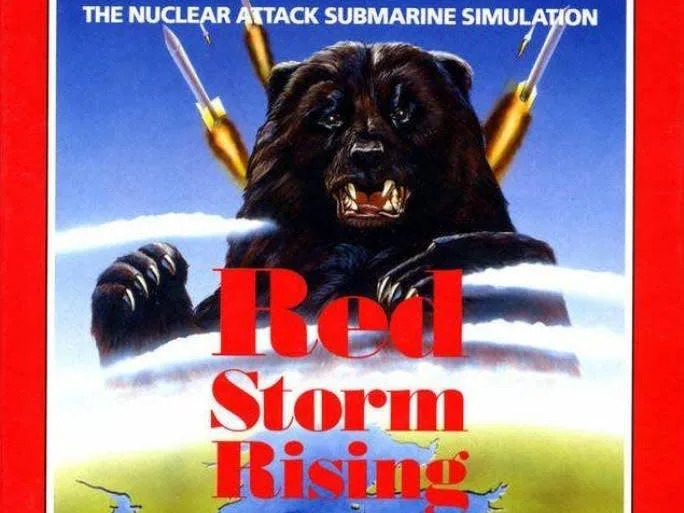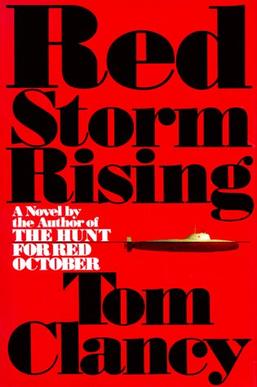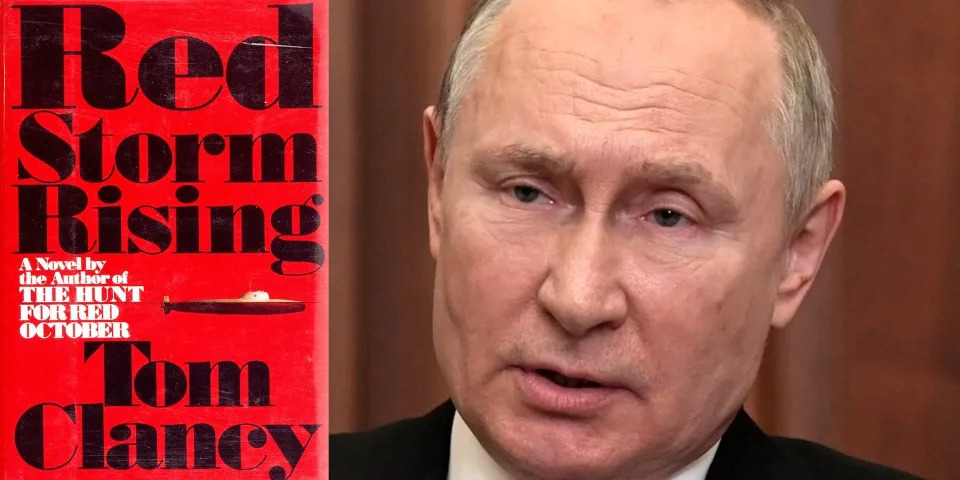RUSSIA INVADES UKRAINE-A NOVEL: A 1986 Tom Clancy novel envisioned a Russia-provoked World War 3 – here’s how it ended

A 1986 Tom Clancy novel envisioned a Russia-provoked World War 3 – here’s how it ended
- In 1986, author Tom Clancy published a novel about a global conflict provoked by the USSR.
- “Red Storm Rising” was one of two Clancy books that takes place outside the Jack Ryan-verse.
- President Reagan reportedly recommended the book to UK Prime Minister Margaret Thatcher.
Spoiler alert: The following article contains spoilers for Tom Clancy’s 1986 novel “Red Storm Rising.”
Ads by:
More than three decades before Russia’s invasion of Ukraine, bestselling author Tom Clancy imagined a scenario that shares similarities with the events that have ruled recent headlines.
Two years after publishing his blockbuster submarine warfare thriller “The Hunt For Red October,” Clancy (in collaboration with war game designer Larry Bond) penned “Red Storm Rising,” a 725-page military techno-thriller about a global conflict provoked by the then-Soviet Union.
The book’s plot: after one of its major oil refineries is destroyed by Azerbaijani militants, the USSR determines it must seize the oil supply in the Persian Gulf, which is protected by NATO. To justify their intentions while keeping the initial attack a secret, the USSR devises a false flag operation by planning an attack on the Kremlin that they blame on NATO-affiliated West Germany.
Ads by:
Memento Maxima Digital Marketing
@[email protected]
SPACE RESERVE FOR ADVERTISEMENT
In real life: Russian officials including Russian leader Vladimir Putin repeatedly based their new military attack on Ukraine on the lie that a genocide was taking place in Ukraine. But a key difference between Clancy’s scenario and the real Russian invasion is that Ukraine is not a part of NATO, the world’s most powerful alliance that includes the nuclear powers the US, France and the UK.
What ensues in Clancy’s book is an action packed, multi-theater military procedural that, at times, feels like something out of a video game. In fact, the author subsequently developed one based on the book – the game was released on the PC, Atari, and Commodore 64 platforms in 1988.
Ads by:
Memento Maxima Digital Marketing
@[email protected]
SPACE RESERVE FOR ADVERTISEMENT
.

.
Ads by:
Memento Maxima Digital Marketing
@[email protected]
SPACE RESERVE FOR ADVERTISEMENT
In Clancy’s book, the crisis is resolved when a KGB-led coup usurps the fictional Russian leader before he is able to launch a nuclear strike on the Allied forces. While a happy ending such as this is common in Clancy’s America-first thrillers, it’s yet unclear that we’ll see a similar outcome in a war that’s already claimed hundreds of lives and forced 800,000 people to flee.
Russian forces attacked Ukraine on February 24, entering from several directions, with troops headed toward its capital, Kyiv. President Joe Biden and other Western leaders have criticized Putin, calling his country’s actions a violation of international law.
Putin brought the threat of nuclear activity to the forefront in recent days when he ordered Russian nuclear forces to shift to a higher state of alert he called “special combat readiness.”
Ads by:
Memento Maxima Digital Marketing
@[email protected]
SPACE RESERVE FOR ADVERTISEMENT
Putin has also accused Ukraine of committing genocide and called its government a Nazi regime, claims for which there is no evidence. In “Red Storm Rising,” the Soviet invasion of West Germany is also based on a lie – in this case a staged terrorist attack engineered by the KGB, resulting in the deaths of Russian schoolchildren.
In the Clancy-verse, the Soviet invasion strategy was triggered by a “maskirovka” or false-flag operation intended to create the perception of a real crime it said was committed by a NATO member country in order to neutralize the organization so that it could move forward with plans to seize oil in the Persian Gulf.
A similar plot emerged in the real world in January, when US intelligence reports suggested that Russia may have been planning a false-flag operation to justify invading Ukraine.
Ads by:
Memento Maxima Digital Marketing
@[email protected]
SPACE RESERVE FOR ADVERTISEMENT
“We have information that indicates Russia has already pre-positioned a group of operatives to conduct a false-flag operation in eastern Ukraine,” an anonymous official told The Washington Post, adding that “the operatives are trained in urban warfare and in using explosives to carry out acts of sabotage against Russia’s own proxy-forces.”
It’s unclear if a definitive false-flag incident devised by Russia ever occurred. A US official accused Russia of being behind a car bombing in rebel-held eastern Ukraine on February 18 that Russian media used to stoke concern that Ukrainian forces were targeting separatist leaders, and Putin’s plan to invade Ukraine forged on. In his speech last week, he justified his plan to invade based on claims about the nation that have been proven to be false. Putin said he was seeking the “denazification” of Ukraine, a country whose democratically elected leader, President Volodymyr Zelensky, is Jewish.
Ads by:
Memento Maxima Digital Marketing
@[email protected]
SPACE RESERVE FOR ADVERTISEMENT
Another justification for Putin’s invasion: the Russian president’s concern over the expansion of NATO, the North Atlantic Treaty Organization, into Eastern Europe and former Soviet Republics, especially Ukraine, which asked to join the alliance in 2008. Putin said the invasion of Ukraine was an act of self-defense against NATO expansion. NATO is a political and military alliance that dates back to 1949 and consists of 30 member countries, including the US, Canada, the UK, France, Belgium, and many other European nations.
Putin has criticized NATO for expanding eastward since the fall of the Soviet Union in 1991. He has said NATO enlisting nations on Russia’s borders represents a provocation, though NATO insists it is a defensive alliance and not a threat to Russia.
Ads by:
Memento Maxima Digital Marketing
@[email protected]
SPACE RESERVE FOR ADVERTISEMENT
NATO figures heavily into the complex plot of “Red Storm Rising.” Early in the story, the Soviet Union knows it cannot seize oil reserves in the NATO-protected Persian Gulf region without antagonizing NATO. Therefore, it neutralizes NATO by implicating member West Germany in the deadly terrorist attack staged in the false-flag incident.
In both the book and in the current war unfolding in Ukraine, the Russian government blamed NATO and NATO-affiliated countries for crises it created. According to NATO, it “suspended practical cooperation with Russia” in 2014, in response to Russia’s aggressive actions against Ukraine, subsequently deploying about 5,000 troops to the Baltic States and Poland in 2016.
Ads by:
Memento Maxima Digital Marketing
@[email protected]
SPACE RESERVE FOR ADVERTISEMENT
“Red Storm Rising” ends in a way we can only hope this horrific war concludes: the crisis is resolved before things get much, much worse.
Read the original article on Insider
Ads by:
Memento Maxima Digital Marketing
@[email protected]
SPACE RESERVE FOR ADVERTISEMENT
Ads by:
Memento Maxima Digital Marketing
@[email protected]
SPACE RESERVE FOR ADVERTISEMENT
Ads by:
Memento Maxima Digital Marketing
@[email protected]
SPACE RESERVE FOR ADVERTISEMENT
Red Storm Rising

First edition cover
|
|
| Author | Tom Clancy |
|---|---|
| Country | United States |
| Language | English |
| Genre | |
| Publisher | G.P. Putnam’s Sons |
|
Publication date
|
August 7, 1986 |
| Media type | Print (Hardcover, Paperback) |
| Pages | 656 |
| ISBN | 0399131493 |
Ads by:
Memento Maxima Digital Marketing
@[email protected]
SPACE RESERVE FOR ADVERTISEMENT
Red Storm Rising is a war novel, written by Tom Clancy and co-written with Larry Bond, and released on August 7, 1986. Set in the mid-1980s, it features a Third World War between the North Atlantic Treaty Organization and Warsaw Pact forces, and is unique for depicting the conflict as being fought exclusively with conventional weapons, rather than escalating to the use of weapons of mass destruction or nuclear warfare. It is one of two Clancy novels, including SSN (1996), that are not set in the Ryanverse.
The book debuted at number one on the New York Times bestseller list.[1] It eventually lent its name to game development company Red Storm Entertainment, which Clancy co-founded in 1997.
Ads by:
Memento Maxima Digital Marketing
@[email protected]
SPACE RESERVE FOR ADVERTISEMENT
Plot summary
Militants from Azerbaijan destroy an oil production refinery in Nizhnevartovsk, threatening to cripple the Soviet Union’s economy due to oil shortages. After much deliberation, the Soviet Politburo decides to seize the Persian Gulf by military force in order to recoup the country’s oil losses. Knowing that the United States had pledged to defend the oil-producing countries in the Persian Gulf, the Soviets decide that neutralizing NATO is a necessary first step before its military operation can take place.
To divert attention from the impending operation, the Politburo embarks upon an elaborate maskirovka to disguise both their predicament and their intentions. The Soviets publicly declare their arms reduction proposal to scrap their obsolete nuclear missile submarines. The KGB then carries out a false flag operation involving a bomb being detonated in a Kremlin building, framing a KGB sleeper agent as a West German intelligence spy involved in the incident. The Politburo publicly denounces the West German government and calls for retaliation. With West Germany neutralized and occupied, the Soviets believe that the United States would not move to rescue the Arab states since it could meet its oil needs from the Western Hemisphere alone.
Even though a planned attack on a NATO communications facility in Lammersdorf was compromised when a Spetsnaz officer was arrested, the Soviets push through with their advance operations in Germany. However, they suffer reverses on the first night of the war, when NATO stealth and fighter-bomber aircraft achieve air superiority over Eastern Europe by eliminating Soviet AWACS and fighter aircraft, as well as bombing many key bridges that much of the Soviet Army has yet to cross.
Nevertheless, the Soviet Navy achieves a decisive early victory against a US Navy carrier group by using air-launched decoy drones to draw the carrier’s air patrol far away while Tu-16 Badger bombers attack from another direction, causing considerable damage. The Soviets secure further advantage by occupying Iceland, taking control of the NATO airbase in Keflavík and ensuring command of the strategically important GIUK gap. U.S. Air Force lieutenant Mike Edwards escapes the attack and hides behind enemy lines, serving as a scout for NATO forces. The Soviet Navy also attack several resupply convoys from North America as well as a NATO carrier battle group in the North Atlantic, causing severe losses to the other side. Meanwhile, the Soviet Air Force engage in a fierce air battle over Norway and later secure a rocket launch site there, bringing key NATO radar and air stations in nearby Scotland within range of sustained air attack.
After much difficulty in occupying West Germany, the Soviet Army, led by General-Colonel Pavel Alekseyev, score a breakthrough in a tank battle over Alfeld, threatening to proceed west of Weser River without heavy resistance from NATO forces. Meanwhile, a naval attack on Soviet bomber bases with cruise missiles launched by NATO submarines paves the way for an amphibious assault on Iceland, retaking the island and effectively closing the Atlantic to Soviet forces. While Edwards is first reinforced by a squad of Royal Marines and then rescued by the United States Marines, a Soviet prisoner on the island reveals the true cause of the war, narrowing down bombing priorities to the Soviet Army’s forward fuel depots and immobilizing the Soviet formations.
In Moscow, the desperate Politburo considers deploying nuclear weapons to stave off defeat. This infuriates Alekseyev, who had been mobilizing for a final counterattack on Germany but faces execution by the Soviet government for its slow timetable. He later takes part in a coup d’etat orchestrated by the KGB in the Kremlin, arresting the government ministers and establishing a troika to temporarily preside over the country. The new Soviet government then negotiates for a ceasefire with NATO and a return to status quo ante bellum, effectively ending the conflict.
Ads by:
Memento Maxima Digital Marketing
@[email protected]
SPACE RESERVE FOR ADVERTISEMENT
Characters
The North Atlantic Treaty Organization
- Edward Morris: Commanding officer of USS Pharris and later USS Reuben James
- Daniel X. McCafferty: Commanding officer of Los Angeles-class submarine USS Chicago
- Robert A. Toland III: NSA analyst and naval reservist, later promoted to commander in the United States Navy Reserve
- Michael D. Edwards, Jr.: First lieutenant in the United States Air Force serving as a meteorological officer at Naval Air Station Keflavik in Iceland. Leads intelligence gathering there during the Soviet occupation of the island with the code name of “Beagle”, later receiving a Navy Cross for his bravery.
- Jerry “The Hammer” O’Malley: Lieutenant Commander in the USN serving as a helicopter pilot aboard Reuben James. Receives a Distinguished Flying Cross for his antisubmarine warfare work.
- Amelia “Buns” Nakamura: F-15C pilot for the USAF who becomes the first American female fighter ace by shooting down three Tu-16 Badger bombers while on ferry duty and later using ASM-135 anti-satellite missiles to destroy at least two Soviet naval radar reconnaissance satellites. She also becomes the first Space Ace because of her satellite shoot-downs.
- Terry Mackall: Sergeant First Class in the United States Army serving as an M1 Abrams tank commander in the 11th Armored Cavalry Regiment on the German front. Receives a battlefield promotion to lieutenant for his valor and leadership skills.
- Colonel Douglas “Duke” Ellington: USAF officer and commander of the F-19 Stealth squadron
- Colonel Charles DeWinter “Chuck” Lowe: Officer in the United States Marine Corps who works with Bob Toland before the conflict and later as the commanding officer of a Marine regiment in the invasion force that recaptured Iceland
- General Eugene Robinson: Supreme Allied Commander Europe
- William Calloway: British Reuters correspondent and SIS agent
Ads by:

Memento Maxima Digital Marketing
@[email protected]
SPACE RESERVE FOR ADVERTISEMENT
The Soviets
- Pavel Leonidovich Alekseyev: Deputy Commander of the Southwest Front and then Commander in Chief-Western Theater after briefly serving as second in command. After the coup, he is made Deputy Minister of Defense and Chief of the General Staff of the Soviet Armed Forces.
- Mikhail Eduardovich Sergetov: Energy Minister and non-voting member of the Soviet Politburo. After the coup, he becomes acting General Secretary.
- Ivan Mikhailovich Sergetov: Alekseyev’s aide-de-camp and Sergetov’s son. Promoted to major during the war.
- Major Arkady Semyonovich Sorokin: Soviet VDV officer whose daughter Svetlana dies in the Kremlin bombing. Later recruited by Alekseyev for the coup.
- Boris Georgiyevich Kosov: Chairman of the Committee for State Security (KGB). Mastermind of the coup, only to be killed in revenge by Major Sorokin.
- Marshal Andre Shavyrin: Chief of the General Staff. Later executed by the Politburo for failing to bring favorable results on the war.
- Marshal Yuri Rozhkov: Commander-in-Chief of the Soviet Army. Executed along with Marshal Shavyrin.
- Marshal Fiodr Borrissovitch Boukharin: Commander of the Kiev Military District. Later promoted to the head of the General Staff after Shavyrin and Rozhkov’s execution, then forced into retirement after Alekseyev’s Coup.
- Andre Illich Chernyavin: Spetsnaz officer assigned to sabotage the NATO command post at Lammersdorf.
Ads by:
Memento Maxima Digital Marketing
@[email protected]
SPACE RESERVE FOR ADVERTISEMENT
Other characters
- Vigdis Agustdottir: Icelandic civilian rescued by Edwards from rapist Soviet soldiers in Iceland
- Patrick Flynn: Associated Press Moscow Bureau chief
- Ibrahim Tolkaze: Militant Islamist of Azerbaijani descent working as an oil field engineer. He and his confederates Rasul and Mohammet instigate the road to war by infiltrating the oil refinery where Ibrahim works, murdering multiple technicians and triggering numerous pipe ruptures that set the entire refinery and adjacent oil field ablaze. All of them are killed when security forces storm the control room.
- Gerhardt Falken: Alleged West German Federal Intelligence Service agent behind the Kremlin bombing
Ads by:
Memento Maxima Digital Marketing
@[email protected]
SPACE RESERVE FOR ADVERTISEMENT
Themes
Red Storm Rising depicts a future Third World War, chiefly between the United States and the Soviet Union. It follows the “future war” genre first popularized by the 1871 novella The Battle of Dorking by George Tomkyns Chesney as well as the science fiction novel The War in the Air (1908) by H.G. Wells. Red Storm Rising is unusual among Cold War examples of the genre in that it presented a war fought entirely using conventional weapons rather than one with nuclear weaponry or chemical weaponry. For instance, The Third World War: August 1985 describes a conflict based on fairly similar assumptions, but involving heavy use of chemical weaponry and with limited use of strategic nuclear weapons at the conclusion of the conflict.
According to a document released by the UK National Archives in December 2015, U.S. President Ronald Reagan had recommended Red Storm Rising to UK Prime Minister Margaret Thatcher shortly after the Reykjavík Summit in 1986 between him and Soviet general secretary Mikhail Gorbachev so as to gain an understanding of the Soviet Union’s intentions and strategy.[2][3] Some of the advanced weapons systems described in the novel were deployed four years later in the Gulf War.[4]
Ads by:
Memento Maxima Digital Marketing
@[email protected]
SPACE RESERVE FOR ADVERTISEMENT
Development
Tom Clancy met Larry Bond in 1982. Clancy had purchased Bond’s wargame Harpoon as a primary source for his future novel The Hunt for Red October (1984).[5] They used the board game’s second edition miniature rules to test key battle sequences, notably the Soviet operation to seize Iceland and the attack on the carrier battle group in the “Dance of the Vampires” chapter, with Bond refereeing the game sessions, which typically involved several players on each side (Clancy among them) acting in various roles.[6]
The two discussed Convoy-84, a wargame Bond had been working on at the time that featured a new Battle of the North Atlantic. The idea became the basis for Red Storm Rising, although Clancy is later referred as the sole author. “I wrote like 1 percent of the book,” remarked Bond. For research on the Politburo scenes, Clancy and Bond interviewed Soviet defector Arkady Shevchenko.[7]
Ads by:
Memento Maxima Digital Marketing
@[email protected]
SPACE RESERVE FOR ADVERTISEMENT
Release
In 1987, the book was published in French as Tempête Rouge (Red Storm), translated by France-Marie Watkins, with the collaboration of Jean Sabbagh.
Reception
Like its predecessor, The Hunt for Red October, the book received critical acclaim for its accurate military narrative. Publishers Weekly praised it as “fascinating and totally credible story, told with authenticity and great suspense”.[8] Kirkus Reviews hailed it as “an informative, readable, sometimes dazzling speculation on superpower war”.[9]
Ads by:
Memento Maxima Digital Marketing
@[email protected]
SPACE RESERVE FOR ADVERTISEMENT
Game adaptations
In December 1988, MicroProse released a Red Storm Rising computer game, in which the player commanded an American submarine against Soviet forces. The player had the option of choosing between both single missions or campaign and which era to play in; modern missions offered the player more advanced submarines and weapons, but also a more technologically advanced adversary as well.
In 1989, TSR, Inc. released the Red Storm Rising board game designed by Douglas Niles, based on the book. The game won the Origins Award for Best Modern-Day Boardgame and Best Graphic Presentation of a Boardgame in 1989.[10]

Ads by: Memento Maxima Digital Marketing
@[email protected]
SPACE RESERVE FOR ADVERTISEMENT
.












